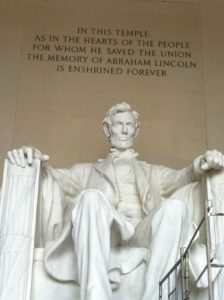 Periodically I check a website called The Lincoln Log to see what was going on in Lincoln’s life on this day throughout his life. Today was an especially busy day.
Periodically I check a website called The Lincoln Log to see what was going on in Lincoln’s life on this day throughout his life. Today was an especially busy day.
The Lincoln Log arose out of a long-term project beginning with Lincoln Day-by-Day: A Chronology, a series of three volumes published in 1960 cataloging the life of Lincoln. The third volume was made possible in part by volunteer work of the Lincoln Group of DC, of which I am a current officer. The Lincoln Log was later augmented by information from the Papers of Abraham Lincoln project, with a special emphasis on Lincoln’s legal work. More information is added periodically. It’s a fun and useful resource.
Which gets to today, May 7th. This date seems to hold several important events in Lincoln’s life over the years.
1832: Lincoln is en route to Rock River in Illinois serving in the Black Hawk War.
1833: Lincoln is appointed postmaster at New Salem by President Andrew Jackson. Lincoln is already identifying himself as a Whig and Jackson is a Democrat more likely to give patronage to party members, Lincoln believes the post office position is “too insignificant to make his politics an objection.”
1837: Lincoln the romantic? Probably not. On this date in 1837 he writes to Mary Owens, whom he has committed to marry despite reservations by both parties. He writes: “I … wish you would think seriously before you decide. . . . My opinion is that you had better not do it. You have not been accustomed to hardship, and it may be more severe than you now immagine.” Lincoln adds, “Whatever woman may cast her lot with mine, should any ever do so, it is my intention to do all in my power to make her happy and contented; and there is nothing I can immagine, that would make me more unhappy than to fail in the effort.” [At least now he is still free to meet Mary Todd…and Joshua Speed]
1852: Jury begins deliberation in Johnston v Jones and Marsh, a case in which Lincoln later serves an attorney. More familiarly known as the “Sand Bar” case, Lincoln deftly handles the environmental and technical aspects of sand accumulating after a rock wall is built, thus affecting the property owned by two Lake Michigan lakeside owners.
1858: Lincoln defends Duff Armstrong, the son of an old friend from his New Salem days, in a murder trial that becomes known as the “Almanac Trial” due to Lincoln’s use of an almanac to dispute the testimony of a key witness. I visited the site of the trial in Beardstown, Illinois.
1861: Lincoln acknowledges a letter from the Republic of San Marino conferring citizenship upon him. He now has dual citizenship.
1862: The presidential party arrives at Fort Monroe, Virginia and boards the USS Monitor. The Monitor was undergoing repairs after its battle with the Confederate ironclad Virginia (formerly the Merrimack). Lincoln confers with General Wool and visits the yacht Vanderbilt, donated by its namesake millionaire to the Union cause.
1863: Lincoln and General Halleck spend the day with General Joseph Hooker and the Army of the Potomac. After returning to Washington he frantically telegraphs Secretary of War Stanton: “Have you any news?” He then writes Hooker to ask him what he plans to do next. Hooker has spent the last several days failing miserably during the Battle of Chancellorsville, one of Robert E. Lee’s best military wins. Stonewall Jackson is wounded by his own men in a “friendly fire” incident and dies soon after.
1864: Lincoln receives first-hand report on the Wilderness campaign from H.E. Wing, who arrives about 2 a.m. on a special locomotive. Lincoln also transmits to the Senate the opinion of his attorney general on the “rights of colored persons in the army or volunteer service.” Lincoln is working to get more equal treatment of black troops.
All of this on May 7th.
I discuss many of these points in my forthcoming book. More on that shortly.
David J. Kent is the author of Lincoln: The Man Who Saved America. His newest Lincoln book is scheduled for release in February 2022. His previous books include Tesla: The Wizard of Electricity and Edison: The Inventor of the Modern World and two specialty e-books: Nikola Tesla: Renewable Energy Ahead of Its Time and Abraham Lincoln and Nikola Tesla: Connected by Fate.
Follow me for updates on my Facebook author page and Goodreads.



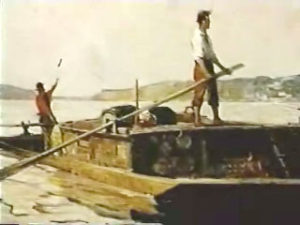 Soon after moving to Illinois, Lincoln made his second flatboat trip to New Orleans. A local entrepreneur and schemer named Denton Offutt approached Lincoln’s relative John Hanks about manning such a journey. Hanks then recruited Lincoln and brother-in-law John Johnston, all of whom now lived in a wooded area west of Decatur near the banks of the Sangamon River. Because of the previous “winter of deep snow,” melting snowpack made the roads impassable by the first of March 1831, forcing the three men to purchase a canoe and paddle down the Sangamon River as far as Springfield, where they expected to find a fully loaded flatboat. Offutt, however, had somehow forgotten to arrange for it.
Soon after moving to Illinois, Lincoln made his second flatboat trip to New Orleans. A local entrepreneur and schemer named Denton Offutt approached Lincoln’s relative John Hanks about manning such a journey. Hanks then recruited Lincoln and brother-in-law John Johnston, all of whom now lived in a wooded area west of Decatur near the banks of the Sangamon River. Because of the previous “winter of deep snow,” melting snowpack made the roads impassable by the first of March 1831, forcing the three men to purchase a canoe and paddle down the Sangamon River as far as Springfield, where they expected to find a fully loaded flatboat. Offutt, however, had somehow forgotten to arrange for it.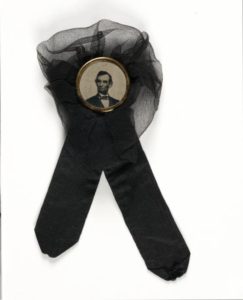 The mood in Washington was euphoric. After four long years the war was nearly over. Lincoln had anticipated this ending in his second inaugural address, reminding northerners that they should welcome southerners back into the Union:
The mood in Washington was euphoric. After four long years the war was nearly over. Lincoln had anticipated this ending in his second inaugural address, reminding northerners that they should welcome southerners back into the Union: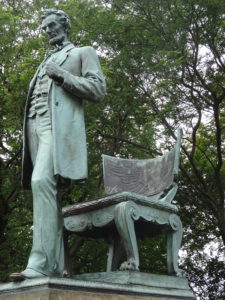 On March 30, 1861, Abraham Lincoln writes to Illinois State Auditor Jesse K. Dubois, who is “sorely disappointed” that Lincoln did not name J. P. Luse to head Minnesota’s Indian Affairs office. The letter gives a glimpse into the difficulties Lincoln faced dealing with our historical treatment of Native Americans.
On March 30, 1861, Abraham Lincoln writes to Illinois State Auditor Jesse K. Dubois, who is “sorely disappointed” that Lincoln did not name J. P. Luse to head Minnesota’s Indian Affairs office. The letter gives a glimpse into the difficulties Lincoln faced dealing with our historical treatment of Native Americans. 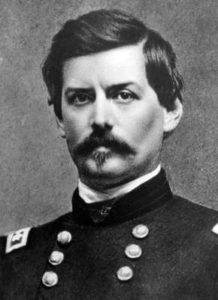 On March 11, 1862, everyone was thinking about George B. McClellan. Lincoln’s cabinet met and groused about their chronic dissatisfaction with the General. Frustrated with McClellan’s “slows,” Lincoln issued War Order No. 3, which fired McClellan as General-in-Chief but retained him as commander of the Army of the Potomac. He spent the rest of the day explaining his decision.
On March 11, 1862, everyone was thinking about George B. McClellan. Lincoln’s cabinet met and groused about their chronic dissatisfaction with the General. Frustrated with McClellan’s “slows,” Lincoln issued War Order No. 3, which fired McClellan as General-in-Chief but retained him as commander of the Army of the Potomac. He spent the rest of the day explaining his decision. 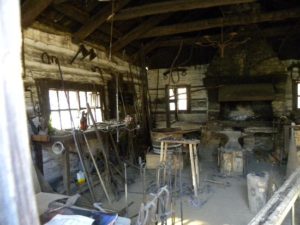 Abraham Lincoln briefly considered apprenticing as a blacksmith. Most subsistence farmers also doubled as tradesmen, working as coopers (barrel makers), tanners (leather makers), distillers (whiskey), brickmakers, shoemakers, or blacksmiths. While still in Indiana he and Dennis Hanks had spent many evenings in the Gentryville general store and at Baldwin’s blacksmith shop trading stories and “yarns,” so Lincoln had seen many an hour of blacksmithing in action.
Abraham Lincoln briefly considered apprenticing as a blacksmith. Most subsistence farmers also doubled as tradesmen, working as coopers (barrel makers), tanners (leather makers), distillers (whiskey), brickmakers, shoemakers, or blacksmiths. While still in Indiana he and Dennis Hanks had spent many evenings in the Gentryville general store and at Baldwin’s blacksmith shop trading stories and “yarns,” so Lincoln had seen many an hour of blacksmithing in action.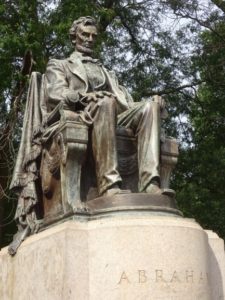 San Francisco targets Abraham Lincoln schools for renaming. Chicago targets Abraham Lincoln and other statues for possible removal. DC Congressional Delegate Eleanor Holmes Norton introduces a bill to remove the Emancipation Memorial statue in Washington, D.C. These efforts are severely misguided, based on political expediency rather than an informed discussion of Lincoln and other past American leaders.
San Francisco targets Abraham Lincoln schools for renaming. Chicago targets Abraham Lincoln and other statues for possible removal. DC Congressional Delegate Eleanor Holmes Norton introduces a bill to remove the Emancipation Memorial statue in Washington, D.C. These efforts are severely misguided, based on political expediency rather than an informed discussion of Lincoln and other past American leaders.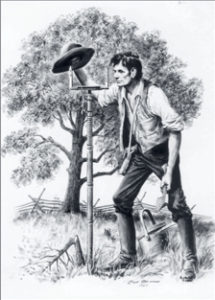 The Sangamon County Deed Record on February 17, 1836 has this notation from Abraham Lincoln, the Surveyor.
The Sangamon County Deed Record on February 17, 1836 has this notation from Abraham Lincoln, the Surveyor.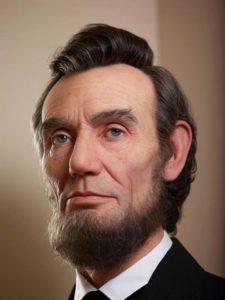 Abraham Lincoln was working in his second floor office on February 10, 1864 when he realized the White House stables were on fire.
Abraham Lincoln was working in his second floor office on February 10, 1864 when he realized the White House stables were on fire.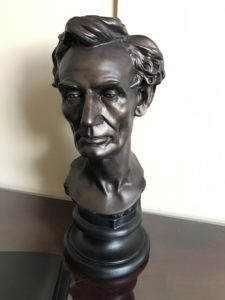 On February 2, 1865, Abraham Lincoln headed to Hampton Roads in Virginia for a peace conference. It almost killed the 13th Amendment.
On February 2, 1865, Abraham Lincoln headed to Hampton Roads in Virginia for a peace conference. It almost killed the 13th Amendment.






